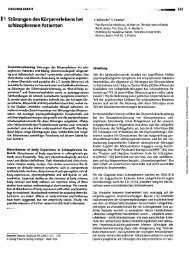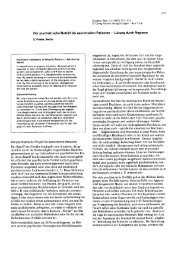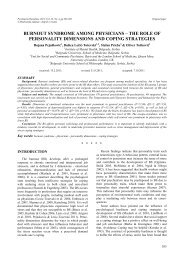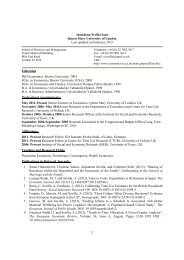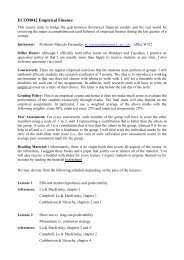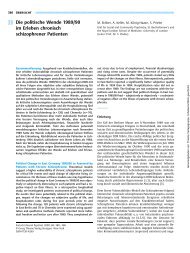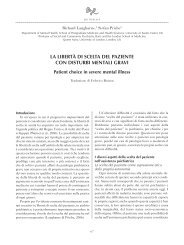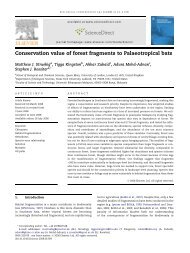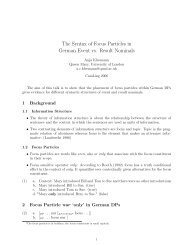Proofs - Personal Webspace for QMUL - Queen Mary, University of ...
Proofs - Personal Webspace for QMUL - Queen Mary, University of ...
Proofs - Personal Webspace for QMUL - Queen Mary, University of ...
Create successful ePaper yourself
Turn your PDF publications into a flip-book with our unique Google optimized e-Paper software.
S46 F. Napo et al. / European Psychiatry 27 (2012) / supplement n°2 / S44-S49<br />
That means that explanatory models previously held by the<br />
patient and his/her family, those which had been created anew<br />
during therapy as well as those <strong>of</strong> the pr<strong>of</strong>essional caregivers<br />
can be communicated by the mediator to the family members<br />
or friends who stayed at home.<br />
In Mali, like in most African countries, the extended family<br />
traditionally includes all members <strong>of</strong> the families (cousins,<br />
sisters, uncles, ancestors etc.) [17,32]. A family member’s<br />
mediator role can help to demystify illness concepts that can<br />
otherwise lead to stigmatisation, <strong>for</strong> example the interpretation<br />
<strong>of</strong> being ‘bewitched by someone’. Thus reintegration is<br />
facilitated and the patient is not isolated from the family. The<br />
isolation <strong>of</strong> the group (family) and the loss <strong>of</strong> the subjective<br />
position in the group have <strong>of</strong>ten been discussed as factors <strong>for</strong><br />
the aetiology and maintenance <strong>of</strong> negative mood states in<br />
African patients [11]. The therapeutic “Koteba” theatre, which<br />
is a part <strong>of</strong> the treatment setting and per<strong>for</strong>med weekly by<br />
the patients to enact typical social confl icts, further supports<br />
exchange between patients and relatives. The Koteba has its<br />
origins in the traditional Bambara theatre and was integrated<br />
as a treatment tool in the 1980ies. Koteba has always been<br />
used as an instrument to break taboos and speak about issues<br />
that are otherwise not allowed to be addressed in traditionally<br />
oriented Malian society.<br />
3. Subjects and methods<br />
We interviewed twenty persons (fi fteen patients and fi ve medical<br />
practioners) with semi- structured, problem- centred qualitative<br />
interviews. All patients who volunteered to participate in our study<br />
suffered from psychotic symptoms caused by schizophrenia or<br />
schizoaffective disorder according to DSMIV/ICD10. All interviews<br />
with the patients and experts except one with a traditional Healer<br />
where conducted at the clinic Pont G. in Bamako, Mali. Data were<br />
collected regarding age, sex, date <strong>of</strong> birth, marital status, ethnicity,<br />
religion and admission status. The interviews were mostly<br />
recorded in “the Toguna” (house) <strong>of</strong> the “therapeutic village”; the<br />
average duration was 1 hour. We gathered our in<strong>for</strong>mation with<br />
the assistance <strong>of</strong> culturally in<strong>for</strong>med translators who were aware<br />
<strong>of</strong> the socio- cultural matrix. This helped avoid linguistic barriers<br />
and facilitated transcultural understanding <strong>for</strong> this study.<br />
Methodologically, we applied qualitative content analysis,<br />
i.e. an approach <strong>for</strong> the methodologically controlled analysis <strong>of</strong><br />
texts within the context <strong>of</strong> communication that follows content<br />
analytical rules and applies step by step models [29]. We selected<br />
this qualitative content analysis approach because the methodology<br />
takes subjective views and social meanings into account,<br />
which allow a better understanding <strong>of</strong> the social reality <strong>of</strong> the<br />
patients. The focus <strong>of</strong> this qualitative approach can be seen as<br />
an attempt to understand the complexity and uniqueness <strong>of</strong> the<br />
subjects being researched [29].<br />
The semi- structured interview guidelines included questions<br />
about how the patients describe their illness or disease,<br />
which key symptoms <strong>of</strong> schizophrenia are experienced by<br />
the patients, what they believe is the cause <strong>for</strong> their problems<br />
and how the patients and their families think they should be<br />
treated. In particular, the last question was constructed and<br />
evaluated in previous research the semi- structured guideline<br />
was fi rst used in 2007, when we examined West African migrants<br />
with psychotic symptoms in the Department <strong>of</strong> Psychiatry <strong>of</strong><br />
Charité, <strong>University</strong> Medical Centre Berlin, Germany [43]. This<br />
fi rst investigation <strong>of</strong> the explanatory models <strong>of</strong> African migrants<br />
gave us an impression how patients <strong>of</strong> West African descent<br />
deal with psychotic symptoms in the Diaspora. We used the<br />
same questionnaire with some variation <strong>for</strong> the present study<br />
as a guideline and redefi ned questions in the fi eld according to<br />
the context and situation while taking the interviews. Flexibility<br />
is a main characteristic <strong>of</strong> the methodology and this was very<br />
important <strong>for</strong> the research, because some <strong>of</strong> the Malian patients<br />
started their narratives spontaneously after we introduced<br />
ourselves (or the caregivers introduced us) as researchers from<br />
Germany who intended to explore patients views and beliefs<br />
about their illness. We explained that we also aimed to learn<br />
from the patients as experts <strong>of</strong> their illness. The introduction<br />
created confi dence, because we explained the purpose <strong>of</strong> the<br />
interviews and asked <strong>for</strong> permission.<br />
The semi- structured interview guideline consisted <strong>of</strong> the<br />
following questions:<br />
1. Why are you in the hospital? Did you have unusual or threatening<br />
experiences or what makes you suffer?<br />
2. How do you explain and integrate your problem/illness/disease<br />
in your lifestory?<br />
3. What things in life make you feel happy and what create fear?<br />
4. How did the family react with regard to your illness?<br />
5. What did the family counsel you to do with regard to your<br />
problem/illness/disease?<br />
6. What is “illness” and what is “healthiness” <strong>for</strong> you?<br />
7. Which activities or treatments help you to recover?<br />
The interviews were analysed with a computer assisted<br />
content analysis programme, ATLAS.ti, to explore the explanatory<br />
models and concepts <strong>of</strong> the West African patients and<br />
pr<strong>of</strong>essional caregivers. The programme ATLAS.ti is an instrument<br />
supporting the analytical work and interpretation <strong>of</strong> the<br />
data by helping to structure the text and to build and group<br />
categories, which can be found in the transcripts according to our<br />
research questions. Moreover, it supports the visual representation<br />
<strong>of</strong> interpreted data, because it <strong>of</strong>fers tools which can be<br />
useful to create networks <strong>of</strong> the explored categories found in<br />
the interviews.<br />
1. In a fi rst step we structured the interview transcripts<br />
and reviewed the texts explicitly with regard to our research<br />
question: How do West African patients and their caregivers<br />
experience and conceptualize illness and disease? We marked<br />
passages in the transcripts, <strong>for</strong> example”my family brought me<br />
to a traditional healer”, which seemed to be <strong>of</strong> importance <strong>for</strong><br />
the study <strong>of</strong> explanatory models and therapeutic activities. This<br />
step can be supported with ATLAS. ti by generating so called<br />
“in- vivo codes”, which give specifi c codes <strong>for</strong> quotations in<br />
the transcripts that were deemed important according to our<br />
research interests.<br />
2. This process <strong>of</strong> paraphrasing was the basis <strong>for</strong> creating<br />
categories. In the course <strong>of</strong> this mostly inductive but also deductive<br />
research process, we defi ned new or redefi ned selected<br />
codes from the fi rst trial, until all important in<strong>for</strong>mation from<br />
the transcripts was included.<br />
The text interpretation always followed the research<br />
question and was put into categories. The process <strong>of</strong> fi nding<br />
<strong>Pro<strong>of</strong>s</strong><br />
08_Napo.indd S46 14/06/2012 14:44:50




